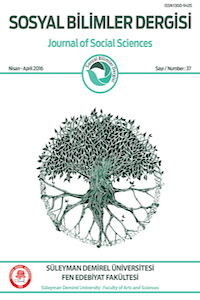KÖROĞLU VE DELİ YUSUF FİLMLERİNİN GÖSTERGELERARASILIK VE METİNLERARASILIK BAĞLAMINDA DEĞERLENDİRİLMESİ
Öz
Diğer sanat
dallarına göre daha geç bir dönemde ortaya çıkan sinema, başta senaryo
hammaddesi olarak kullanmak üzere kimi edebî ürünlerin kurgu, biçim ve izlek
gibi özelliklerinden faydalanır. Uyarlama yolu ile sinemaya taşınan metin ve
anlatıların, yeni bir bağlamda kurgulanışı ve bir yapıttan diğerine taşınan
biçim ve anlam kesitlerine yüklenen yeni değerler, söz konusu sanat dallarının
göstergelerarasılık ve metinlerarasılık bağlamında incelenmesine olanak sağlar.
Böylece yeni üretilen eserlerin, kaynak aldığı yapıların ortaya çıkarılması
imkânı ve bu eserlerde yer alan anlam ve biçim ögelerinin diğer yapıtlarda ne
oranda yer aldığı ortaya konur. Bu çalışmada Köroğlu Destanı’nın Köroğlu
Filmine uyarlanışı göstergelerarasılık, Köroğlu
ve Deli Yusuf filmleri ise metinlerarasılık
bağlamında çözümlenmeye çalışılacaktır.
Anahtar Kelimeler
Kaynakça
- Acınan, Başak (2011). Türk Sinemasında ‘Köroğlu Destanı’, Hacettepe Üniversitesi, Sosyal Bilimler Enstitüsü, Türk Dili ve Edebiyatı Anabilim Dalı, Türk Halkbilimi Bilim Dalı, Yayınlanmamış Yüksek Lisans tezi, Ankara.
- Adanır, Oğuz (2003). Sinemada Anlam ve Anlatım, İstanbul: Alfa Yayınları.
- Aktulum, Kubilay (2011). Metinlerarasılık Göstergelerarasılık, Ankara: Kanguru Yayınları.
- Aktulum, Kubilay (2014). Metinlerarası İlişkiler, Kanguru Yayınları.
- Aktulum, Kubilay (2011). Müzik ve Metinlerarasılık –Müziklerarası/Göstergelerarası Etkileşim ve Aktarımlar, İstanbul: Çizgi Kitabevi.
- Bazın, André (2011). Sinema Nedir?, (Çeviren: İbrahim Şener), İstanbul: Doruk Yayınları.
- Boratav, Pertev Naili (1982). Folklor ve Edebiyat II. İstanbul: Adam.
- Çobanoğlu, Özkul (2003). Türk Dünyası Epik Destan Geleneği, Ankara: Akçağ.
- Gariper, Cafer (2015). Sabahattin Ali‟nin Kağnı Hikâyesiyle Nâzım Hikmet‟in Kuvayi Milliye Destanında Kağnı Ögesi Etrafında Kimi Benzerlikler. Yeni Türk Edebiyatı Araştırmaları Dergisi, S.14, İstanbul: Türk Edebiyatı Vakfı Yay.
- Gariper, Cafer (2015). “Cengiz Aytmatov’un Al Yazmalım Selvi Boylum Hikâyesi ve Göstergelerarasılık”, Bilig Türk Dünyası Sosyal Bilimler Dergisi, Yaz 2015, Sayı 74. s.71-96. Özön, Nijat (2008). Sinema Sanatına Giriş, İstanbul: Agora Kitaplığı.
- Tarkovski, Andrey (2006). Şiirsel Sinema, (Derleyen: John Gianvito, Çeviren: Ebru Kılıç), İstanbul: Agora Kitaplığı.
Öz
The cinema, which emerges later than
other art branches, benefits from the features of some literary products such
as fiction, form and trace, in order to use them as scenario raw materials. The
texts and narratives conveyed to the cinema through adaptation are constructed
in a new context and the new values loaded into the forms and meaning sections
carried from one structure to the other allow the study of the branches of art
in the context of intergovernmental and intertextuality. Thus, the possibility of uncovering the structures from which
the new works are produced, and the meaning and form of these artifacts are
revealed in the other works. In this study, the adaptation of the Köroğlu
Destanı to the Köroğlu film will be
tried to be solved in the semiotic context and, Köroğlu and Deli Yusuf
films will be tried to be solved in the context of intertextuality
Anahtar Kelimeler
Kaynakça
- Acınan, Başak (2011). Türk Sinemasında ‘Köroğlu Destanı’, Hacettepe Üniversitesi, Sosyal Bilimler Enstitüsü, Türk Dili ve Edebiyatı Anabilim Dalı, Türk Halkbilimi Bilim Dalı, Yayınlanmamış Yüksek Lisans tezi, Ankara.
- Adanır, Oğuz (2003). Sinemada Anlam ve Anlatım, İstanbul: Alfa Yayınları.
- Aktulum, Kubilay (2011). Metinlerarasılık Göstergelerarasılık, Ankara: Kanguru Yayınları.
- Aktulum, Kubilay (2014). Metinlerarası İlişkiler, Kanguru Yayınları.
- Aktulum, Kubilay (2011). Müzik ve Metinlerarasılık –Müziklerarası/Göstergelerarası Etkileşim ve Aktarımlar, İstanbul: Çizgi Kitabevi.
- Bazın, André (2011). Sinema Nedir?, (Çeviren: İbrahim Şener), İstanbul: Doruk Yayınları.
- Boratav, Pertev Naili (1982). Folklor ve Edebiyat II. İstanbul: Adam.
- Çobanoğlu, Özkul (2003). Türk Dünyası Epik Destan Geleneği, Ankara: Akçağ.
- Gariper, Cafer (2015). Sabahattin Ali‟nin Kağnı Hikâyesiyle Nâzım Hikmet‟in Kuvayi Milliye Destanında Kağnı Ögesi Etrafında Kimi Benzerlikler. Yeni Türk Edebiyatı Araştırmaları Dergisi, S.14, İstanbul: Türk Edebiyatı Vakfı Yay.
- Gariper, Cafer (2015). “Cengiz Aytmatov’un Al Yazmalım Selvi Boylum Hikâyesi ve Göstergelerarasılık”, Bilig Türk Dünyası Sosyal Bilimler Dergisi, Yaz 2015, Sayı 74. s.71-96. Özön, Nijat (2008). Sinema Sanatına Giriş, İstanbul: Agora Kitaplığı.
- Tarkovski, Andrey (2006). Şiirsel Sinema, (Derleyen: John Gianvito, Çeviren: Ebru Kılıç), İstanbul: Agora Kitaplığı.
Ayrıntılar
| Bölüm | Makaleler |
|---|---|
| Yazarlar | |
| Yayımlanma Tarihi | 29 Aralık 2017 |
| Yayımlandığı Sayı | Yıl 2017 Sayı: 42 |
Kaynak Göster
Süleyman Demirel Üniversitesi Fen-Edebiyat Fakültesi Sosyal Bilimler Dergisi


